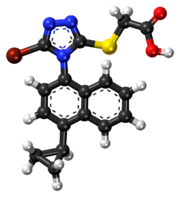 | |
 | |
| Clinical data | |
|---|---|
| Pronunciation | /lɛˈsɪnjuːræd/ le-SIN-ew-rad |
| Trade names | Zurampic |
| AHFS/Drugs.com | Monograph |
| MedlinePlus | a616015 |
| License data | |
| Routes of administration | Oral (tablets) |
| ATC code | |
| Legal status | |
| Legal status | |
| Pharmacokinetic data | |
| Bioavailability | ~100%[2] |
| Protein binding | >98% |
| Metabolism | Hepatic (CYP2C9) |
| Elimination half-life | ~5 hours |
| Excretion | Urine (63%), feces (32%) |
| Identifiers | |
| |
| CAS Number | |
| PubChem CID | |
| DrugBank | |
| ChemSpider | |
| UNII | |
| KEGG | |
| ChEBI | |
| CompTox Dashboard (EPA) | |
| ECHA InfoCard | 100.216.089 |
| Chemical and physical data | |
| Formula | C17H14BrN3O2S |
| Molar mass | 404.28 g·mol−1 |
| 3D model (JSmol) | |
| |
| |
Lesinurad (brand name Zurampic) is a urate transporter inhibitor for treating high blood uric acid levels associated with gout.[2] It is recommended only as an adjuvant with either allopurinol or febuxostat when these medications are not sufficient.[3]
It received FDA approval on 22 December 2015.[3] The European Commission granted a marketing authorisation valid throughout the European Union on 18 February 2016.[4] In February 2019, lesinurad was discontinued in the United States by its manufacturer for business reasons, and was subsequently withdrawn in Europe in July 2020.[5][6]
- ^ "Prescription medicines: registration of new chemical entities in Australia, 2016". Therapeutic Goods Administration (TGA). 21 June 2022. Retrieved 10 April 2023.
- ^ a b "Zurampic (lesinurad) Tablets, for Oral Use. Full Prescribing Information" (PDF). AstraZeneca AB, S-151 85 Sodertalje, Sweden. Archived from the original (PDF) on 24 December 2015. Retrieved 23 December 2015.
- ^ a b "Drug Trial Snapshot: Zurampic". US Food and Drug Administration. 22 December 2015. Retrieved 14 October 2018.
- ^ "EPAR summary for the public" (PDF). EMA. 13 March 2016.
- ^ "Duzallo and Zurampic". Ironwood Pharmaceuticals. Archived from the original on 10 August 2020. Retrieved 31 July 2020.
- ^ "Duzallo". European Medicines Agency. The European Union. 17 September 2018. Retrieved 2 October 2020.